Accessibility Tools and PNP Profile
Students can access various tools during testing. The zoom tool is available through the TestNav app, and others tools are made available during student registration.
Zoom
Students can zoom in (up to 500%) and out on a test page, depending on which TestNav app they use to test.
- Depending on how a test is configured, students might see the zoom option in the user dropdown. In this scenario, students can select the user dropdown and select the plus button to zoom in or the minus button to zoom out. Students can see the magnification percentage go up or down as they select these buttons.
- When students zoom in at high levels, a More menu appears that contains the buttons, tools, and accommodations that normally appear at the top of the page or in the user-dropdown menu.
TestNav for desktop
- In Windows:
- Press Ctrl + to zoom in.
- Press Ctrl - to zoom out.
- Press Ctrl 0 to reset to default zoom.
- In OS X or macOS
- Press Cmd + to zoom in.
- Press Cmd - to zoom out.
- Press Cmd 0 to reset to default zoom.
TestNav on Chrome OS
- Press Ctrl + to zoom in.
- Press Ctrl - to zoom out.
- Press Ctrl 0 to reset to default zoom.
TestNav on Android and iOS
To zoom, use two fingers on the screen and:
- Pinch out to zoom in.
- Pinch in to zoom out.
Accessibility Tools via Registration
After you register students and set access for accessibility tools, students may use them during their online tests. The videos below demonstrate how students interact with these tools.
For details on configuring accessibility tool settings, see PNP Profile and Accessibility below.
Alternate Mouse Pointers
Low vision students can have alternate mouse pointers set prior to testing to help them see pointers as they navigate through the test.
In a practice test, students can select the pointer size and color on the Settings page. In a non-practice test, each student's pointer setting is configured through his or her PNP. Only one pointer setting is allowed per student, per test session. To update the pointer setting after a student has signed into a test:
- For a practice test, the student signs out and the proctor must resume the test, which allows the student to access the Settings page, again.
- For a non-practice test, the student signs out and his or her registration must be updated to reflect another pointer setting.
Mouse Pointer sizes and color options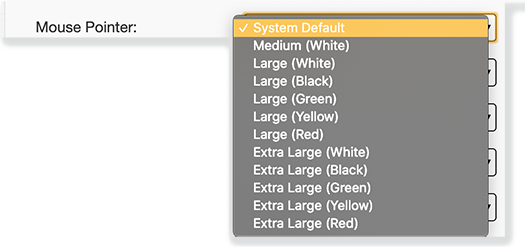
Color Contrast
Students can set color contrast to view items and some TestNav elements more clearly.
Screen Reader
Blind or visually impaired students can use a screen reader to read test content (and TestNav user interface elements) either thorough audio output or on a braille display.
Pearson currently supports NVDA, JAWS, and VoiceOver screen readers for use with TestNav. While other screen readers might work with TestNav, Pearson tests and confirms only NVDA, JAWS, and VoiceOver functionality with TestNav.
To use NVDA or JAWS screen readers with secure tests (running in kiosk mode), an administrator for your program must add specific executable files to the allowlist within your assessment management system. See your Pearson program team for details.
American Sign Language (ASL)
Students can view a video with a person translating the item text to ASL.
Answer Masking
Students provided the option to use the Answer Masks tool can select it from the User drop-down menu. When selected, students see a mask covering multiple-choice distractors, with the option to click to expose each individually. They can turn answer masking on and off over each distractor or turn answer masking on or off on the entire question.
Line Reader Mask
Students provided the option to use the Line Reader Mask see the option in the User drop-down menu. The Line Reader Mask helps the student to focus on specific parts of the item. The student can select and drag both handles to whatever size they need to show and hide as much as the item they want to focus on, like a word, phrase, or any portion. They can also select and drag the move icon to move the window around in the mask.
They can change this as much as they like as they work through their test questions. To close the Line Reader Mask, the student can go back to the user dropdown and select Hide Line Reader Mask.
Alternative Line Reader
Students provided the option to use the Line Reader can use it to highlight a row of text. They can use keyboard keys to move through the text. The student can select answers using the keyboard while using the Line Reader. This is an alternative to the Line Reader Mask above. It is enabled with PNP/OFS.

Text-to-Speech (TTS)
Students provided the option for TTS can hear text read aloud by clicking the play button to the right of the item, or by selecting text within the item.
- Pressing the play button triggers the button to turn into a stop button, and TTS continues to play, unless the student clicks the stop button.
- Selecting text within the item triggers the
 button to appear. The student can click the button to play a previously designated chunk of surrounding text, but not the entire item.
button to appear. The student can click the button to play a previously designated chunk of surrounding text, but not the entire item.
Skip Passage Text for reading items...
Programs can use the SkipPassageText PNP configuration within reading assessments in which students should not hear passages read loud. See SkipPassageText in the Accommodations and PNP table below.
Items can be configured to allow for exceptions for parts of text that should be read (for example, instructional text).
Use your speakers/headphones to hear the TTS.
Dynamic TTS(D-TTS) provides TTS through student operating systems (OSs), but the tool functionality is the same. D-TTS provides the following options, depending on their availability in the testing device OS.
Voice names by OS/Language
| OS/Language | Names |
|---|---|
| macOS | Alex |
| Fred | |
| Samantha | |
| macOS Spanish | Juan |
| Paulina | |
| Jorge | |
| Diego | |
| Windows | Anna |
| David | |
| Zira | |
| Windows Spanish | Sabina |
| Helena | |
| Pablo | |
| Raul | |
| iPadOS | Samantha |
| iPadOS Spanish | Monica |
| Paulina | |
| ChromeOS | ChromeOS US English |
| ChromeOS Spanish | ChromeOS US español |
TTS by Play Button
TTS by Listen Button
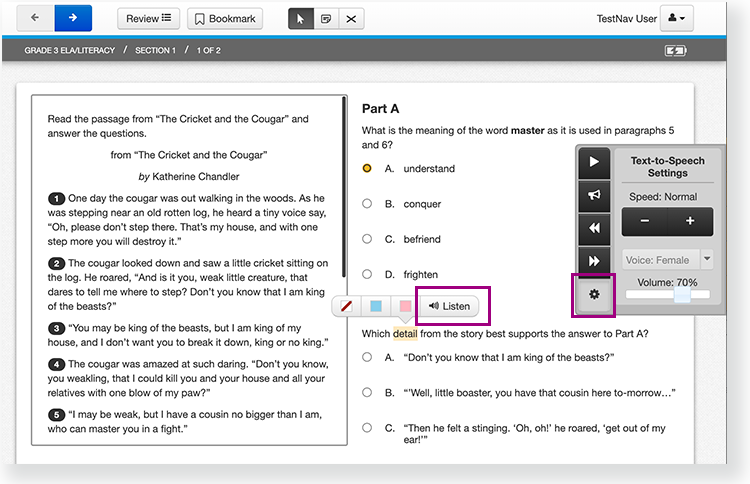
Readable Mode
Students provided the option for Readable Mode can see a two-column item in a single, scrollable pane to increase their ability to concentrate on item content.
To enable Readable Mode, students can click the user dropdown and select Enable Readable Mode. They can click Disable Readable Mode to revert back to the two-column view.
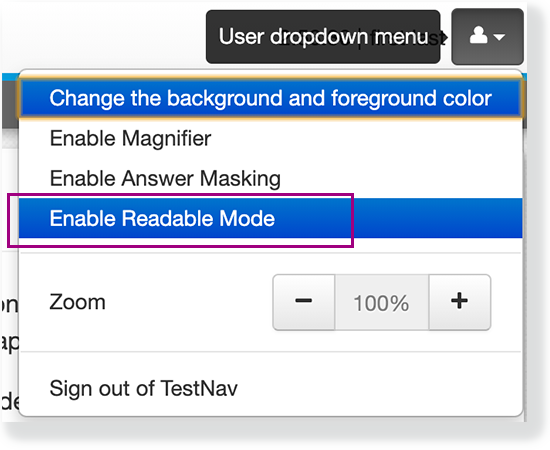
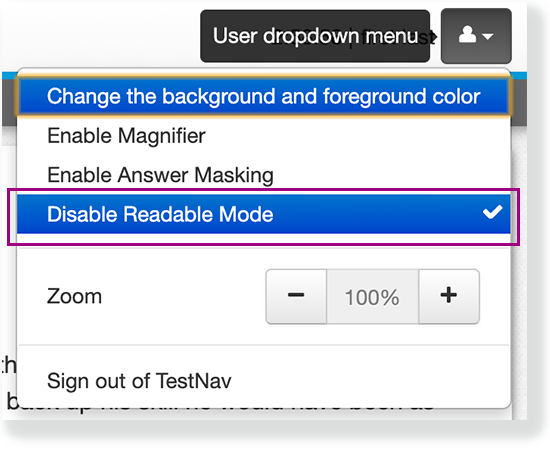
Readable Mode enabled
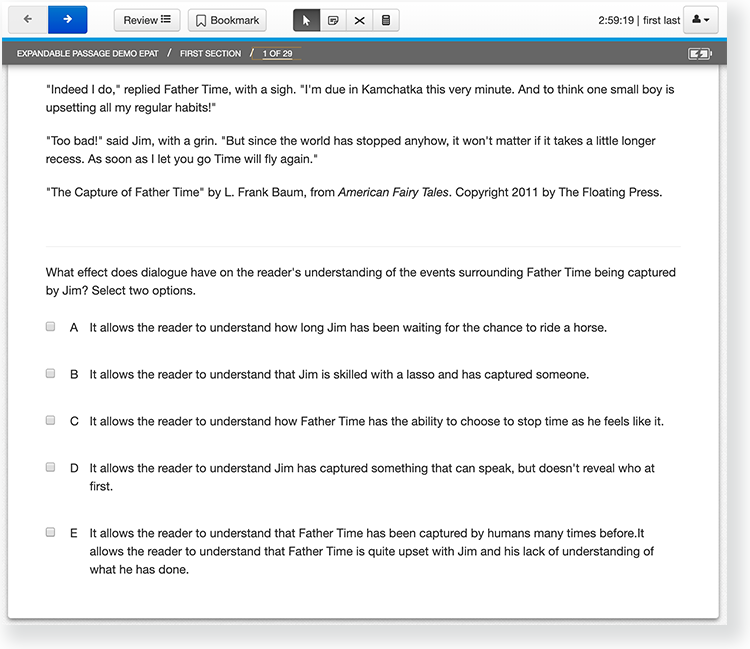
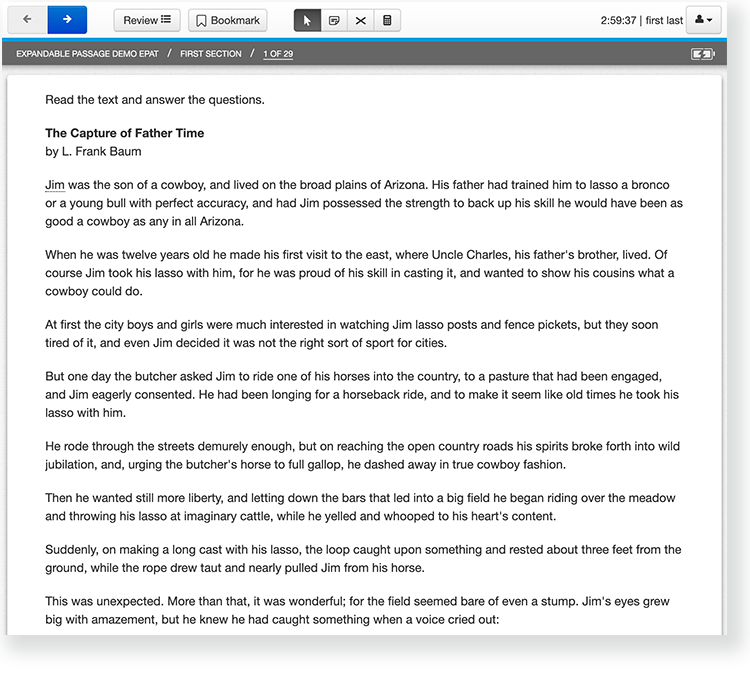
White Noise
Students provided the option for the White Noise tool can select one of three white noise options to help them concentrate on test content. To use the White Noise tool, students can:
- Click the user dropdown and select Open White Noise. The White Noise tool displays and students can drag it around the TestNav window to their liking.

Click within the tool to control it.
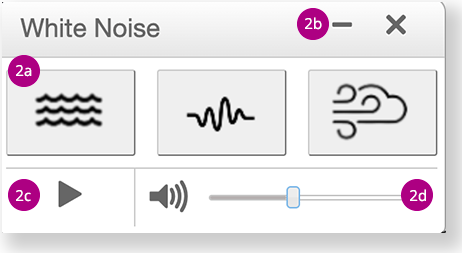
2a - Click each white noise option (Waves, White Noise, or Wind) to hear them.
2b - From left to right, select the minimize tab to hide the window, and select the X to turn off the tool.
2c - Select the Play/Stop button to pause and play the sound.
2d - Slide the volume control to adjust the volume.
No Response
Some TestNav tests are set up to require students to select an answer for each item before they can move on to the next item. Students provided accommodations, at times, require a scribe (or proctor) to sign in to a student's online test and enter that student's responses.
As a scribe enters student responses, at times, they encounter a scenario in which a student does not provide a response for every item. If provided the No Response accommodation, in this scenario, the proctor can click the user dropdown and select No Response to move forward to the next item.
A pop-up appears and the scribe must select Yes to mark the item as No Response or No to enter a response.
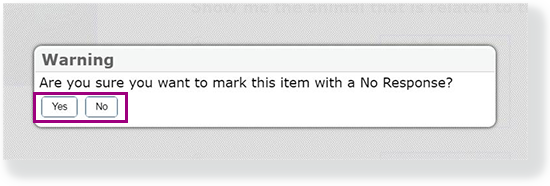
PNP Profile and Accessibility
The Personal Needs and Preferences (PNP) profile describes a student’s testing needs and preferences in a digital environment. A student's PNP profile tells the test delivery system what the needs are for that particular student. When an administrator registers a student, the registration system passes the PNP accommodation that the student needs to successfully test in TestNav.
The PNP profile is one area of the Accessible Portable Item Protocol (APIP™) standard, which aims to make tests and test items accessible for students with a variety of disabilities and special needs.
The registration system (like PearsonAccess or Aspire) needs to implement the API calls for PNP accommodations to work.
Accommodations
Accommodations alter how items are presented, allowing students with disabilities to complete the same assignments as their peers. Accommodations do not alter assignment content, give students an unfair advantage, or change what a test measures. They do make it possible for students with certain disabilities to show what they know without being impeded by their disabilities.
Deaf and Hard-of-Hearing
- ASL videos - American Sign Language Videos
- Closed Captioned videos
Low Vision
- Screen Readers
- Color Contrast Settings
- Magnification
- Line Readers
- Alternate Pointers
Blind
- Screen Readers
- Braille
Learning disabilities
- Additional Testing time
- Text-to-Speech (TTS)
- Line Reader
- No Response
- Readable Mode
- White Noise Generator
Mobility disabilities
- Assistive Technologies
- Keyboard Navigation
- Additional Testing Time
Accommodations and PNP
Three areas — Form, Registration, and/or TestNav Delivery — control each accommodation. The table below illustrates which area controls each, as well as details when applicable. You can also expand the following section to view current accommodations, data, and scenarios.
Table Key
- Does not control
- Does control
- Dependent on PNP - If PNP is not used, then the form controls what is displayed. If PNP is used, then it overrides the form.
Accommodation | Form controlled | Student registration controlled | TestNav controlled |
| Alternate pointers | |||
Additional testing time |
| ||
Answer masking |
| ||
ASL |
| ||
Assistive technologies |
|
| |
Braille |
| ||
Closed caption |
| ||
Color contrast |
|
| |
| Dictionary | |||
| Expandable View | |||
Keyboard navigation |
|
| |
Line reader mask |
|
| |
Line reader (alternate) | |
| |
Magnification |
| ||
| No Response | |||
| Readable Mode | |||
Screen readers |
|
|
|
| Self-guided tutorial | |||
| Spell Check | |||
Text-to-speech (TTS) |
| ||
| Dynamic TTS (D-TTS) | |||
Skip Passage Text (only applicable if TTS or D-TTS is also enabled) | |||
| White Noise Generator | |||
Four-function Calculator | |||
| Five-function Calculator | |||
| Scientific Calculator | |||
| TI Graphing Calculator | |||
| TI 108 Basic Calculator | |||
| TI-30 Scientific Calculator | |||
| Desmos Four-function Calculator | |||
| Desmos Scientific Calculator | |||
| Desmos Graphing Calculator |
Third-party extensions
Note that third-party extensions also provide accommodations through PNP. TestNav supports the use of these extensions; however, extension availability is determined by the program owner.
- Fedora does not support Co:Writer.
- Web extensions on non-secure tests are supported only on Chrome browser.
- Known issues with Read&Write on iOS:
- After a tester uses Talk & Type, if another tester uses the same device without closing and relaunching the TestNav app, the Talk & Type feature will not be available because the permission to use the tester’s microphone was not presented and approved by the tester.
- Click to Speak functionality does not work on Start/Welcome Page, terms & Conditions page, and Start/End Section Pages.
If previously configured in the student's PNP (see below), extensions available to the student appear on the Select Extensions page. To access the extension during the test, the student can:
Select Enable for each extension they want to use during the test, and then select Continue to Test.
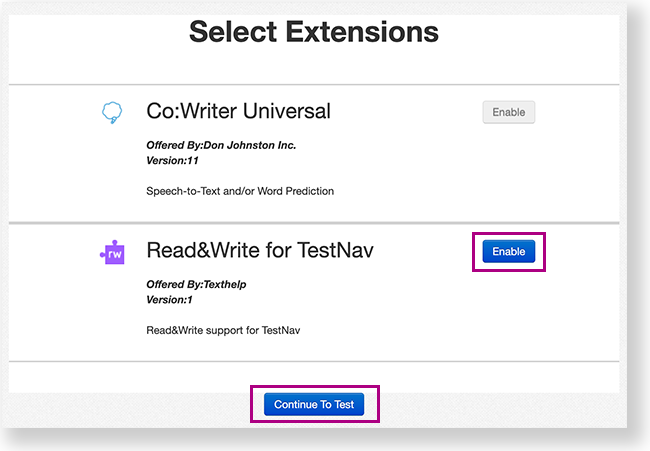
- The example below shows the Read&Write extension. The student can select:
- Extension option buttons to begin using it.
Add More Extensions to add other extensions. Note that if a settings button appears, students can select it to alter settings.
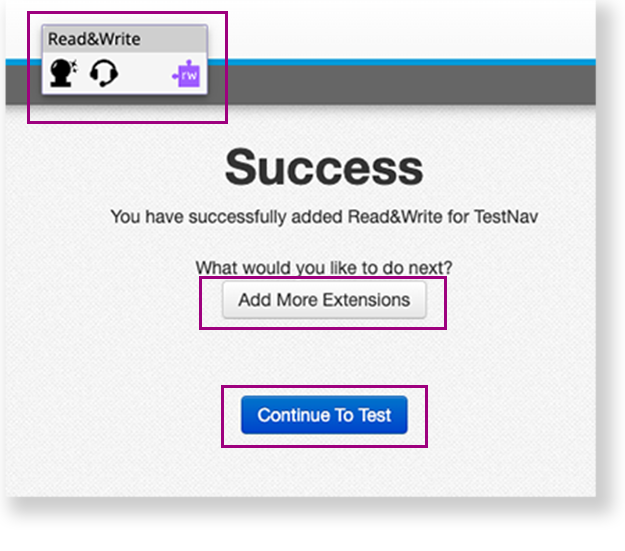
Note that controls the student sees can vary depending on their PNP. If no PNP exists, the student sees the default set of controls.
Select Continue to Test to go to the test and begin.
Other extensions might require an additional sign in to load your personal settings.
Co:Writer Example
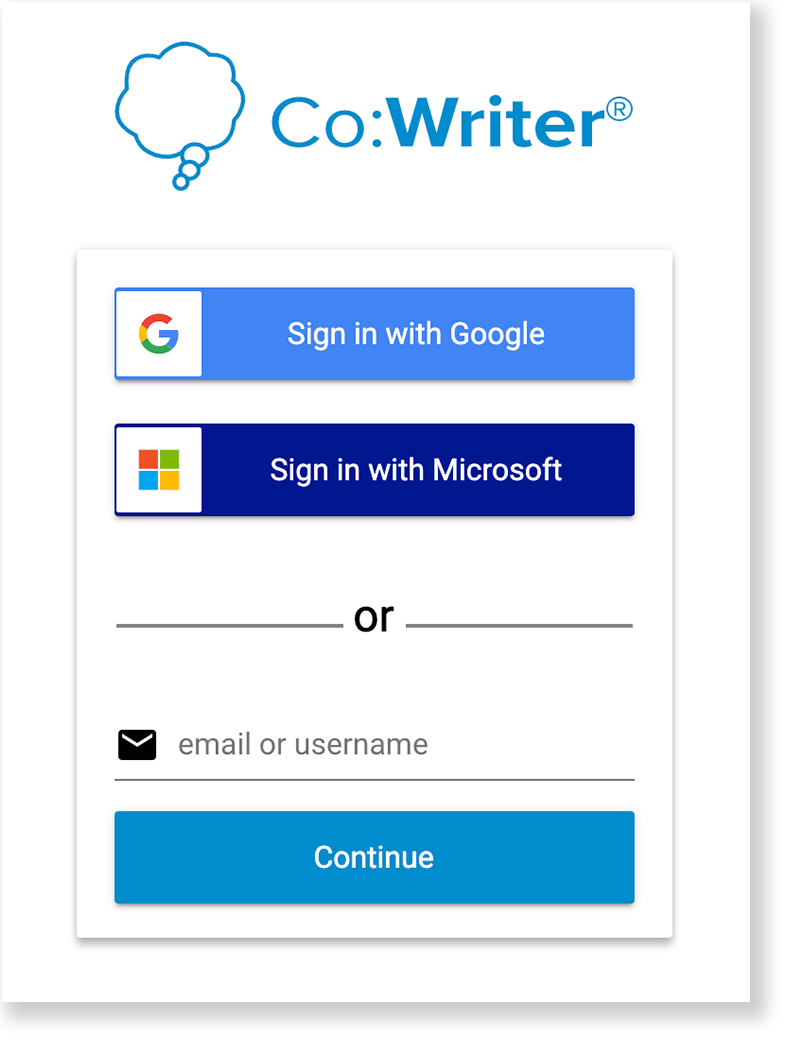
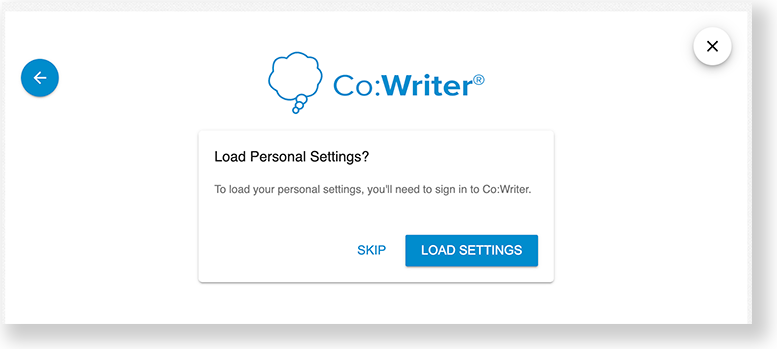
Current TestNav Accommodations Available Through PNP
Alternate Pointers (mousePointer) - Allows students the use of a previously specified alternate mouse pointer during testing. To give a student an alternate mouse, enable the assignSupport flag, and provide the the pointer size and color using one of the PointerType valid values specified below:
large-black
extra-large-black
medium-white
large-white
extra-large-white
large-green
extra-large-green
large-yellow
extra-large-yellow
large-red
extra-large-red
Add Time - Allows students additional testing time during a timed test. To give an student additional testing time, provide the addTime node in the registration APIs (before the student logs into the test), and include these settings:
- support: "true"
- mult (multiplier): 0 (zero) or a value in the 1.1-10.0 range
A 0 (zero) mult value causes the test to deliver a timed form or timed sections on a timed form without a timer. A 1.1-10.0 mult value results in that test form's timer value multiplied by the mult value. For example, a mult of 1.5 for a one-hour test results in the student having a 90-minute timer instead of a 60-minute timer.
Tests ignore the addTime node if:
- The test is untimed.
- Support is set to anything besides true.
- Mult is set to any value other than 0 or a value in the 1.1-10.0 range.
Any changes you make to the addTime node after the student first logs into the test will also not affect the timer.
Answer Mask - Limits what students sees to help them focus on sections of text. Based on the PNP, multiple choice item choices are masked when the item is first presented. The student can turn masks on or off at any time.
Line Reader - Assists student to read content by moving a reading tool down line-by-line. Based on the PNP the registration system supplies.
Color Contrast (background/font color) - Allows student to choose a text and background color combination different from the default presentation. Helps students with visual discrimination problems. Based on the PNP the registration system supplies.
Available color choices include:
- black-cream (black on cream)
- black-lblue (black on light blue)
- black-lmagenta (black on light magenta)
- white-black (white on black)
- yellow-blue (yellow on blue)
- dgray-pgreen (gray on green)
Screen Reader - Allows students to use screen readers during secure tests. Only allows specified screen readers supplied in the PNP from the registration systems to run during secure tests.
For non-secure tests, screen readers are not restricted, and PNP settings do not have any impact.
Spell Check - Allows students to check their spelling within the rich text editor.
Calculator (must configure in assessment management system) -
- Four-function - Allows for a four-function calculator accommodation on a non-calculator section of a test.
- Five-function - Allows for a five-function calculator calculator accommodation on a non-calculator section of a test.
- Scientific - Allows for a scientific calculator accommodation on a non-calculator section of a test.
- TI Graphing - Allows for a TI Graphing calculator accommodation on a non-calculator section of a test.
- TI 108 Basic- Allows for a TI 108 Basic calculator accommodation on a non-calculator section of a test.
- TI-30 Scientific- Allows for a T130 Scientific calculator accommodation on a non-calculator section of a test.
- Desmos Four-function - Allows for a Desmos Four-function calculator accommodation on a non-calculator section of a test.
- Desmos Scientific - Allows for a Desmos Scientific calculator accommodation on a non-calculator section of a test.
- Desmos Graphing - Allows for a Desmos Scientific calculator accommodation on a non-calculator section of a test.
Readable Mode
See description above.